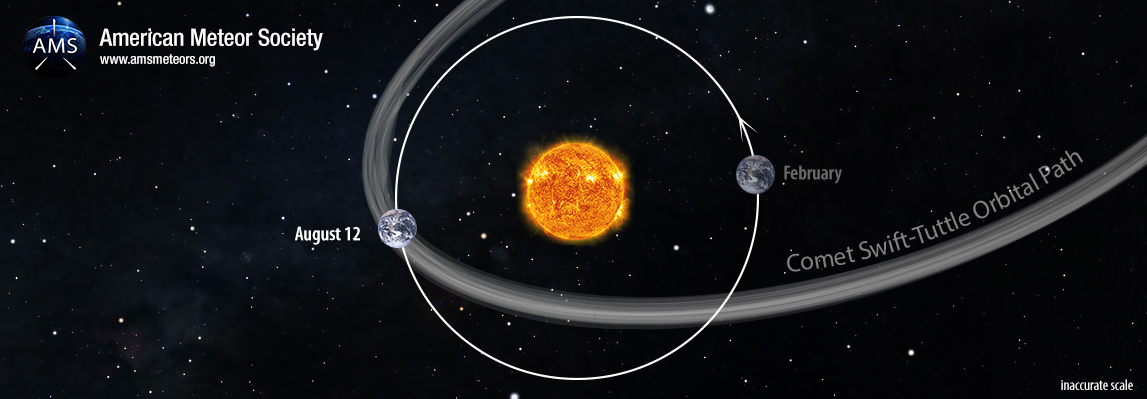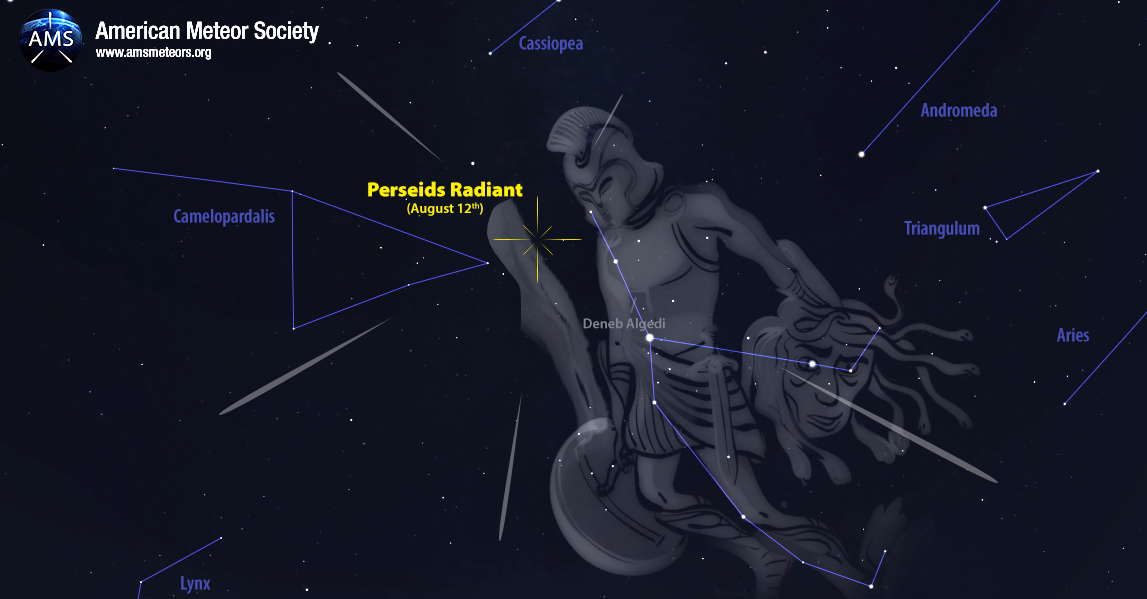
(Olympus Corp. E-M10 Mark III, 8mm, 1s, f/1.8, ISO1600)
The Perseids are often the most impressive Meteor Shower of the year for the Northern Hemisphere. The Perseid meteor shower offers a consistently high rate of meteors every year and it occurs in August when the temperatures are usually nice enough for a night under the stars!
Comet Dust
Each July and August the Earth encounters debris left behind from comet 109P/Swift-Tuttle. This comet has an orbit of 133 years and last entered the inner solar system in 1992. Even though the comet now lies in the outer portions of the solar system, far away from Earth, we still encounter debris that has been left behind during the many trips this comet has made through the solar system.
This meteor shower is perhaps the most popular as it is active during the summer months in the northern hemisphere. There are stronger meteor showers but they appear during the colder time of year in the northern hemisphere when conditions are less inviting. The strength of each Perseid display varies year to year, mainly due to lunar conditions. If a bright moon is above the horizon during the night of maximum activity, then the display will be reduced. Most of the Perseid meteors are faint and bright moonlight will make it difficult to view. Such is the case in 2020 when a bright half-moon will rise near midnight and temper the show just when the activity kicks into high gear.
August 11th / 12th
To view the Perseids at their best, you need to know when to watch. During the evening hours the radiant, the area of the sky where Perseid meteors shoot from, is located low in the northern sky. This is the worst time to try and view the shower for sheer numbers as most of the activity will occur beyond your line of sight, being blocked by the horizon. The few that do come your way this time of night are special. The reason is that they just skim the upper regions of the atmosphere and will last much longer than Perseids seen during the morning hours. Since they last longer they also will travel a much longer distance across the sky. Most of these “earthgrazing” Perseids will be seen low in the east or west, traveling north to south. Occasionally one will pass overhead and will be unforgettable as you watch it shoot across the sky for several seconds. While these meteors are few, they are certainly worth the effort to try and catch. Since the moon will interfere with morning meteor observing, more emphasis should be on viewing prior to midnight this year.
As the Earth rotates and the time approaches local midnight, the Perseid radiant has risen higher into the northeastern sky. The meteors are now shorter and last only a few tenths of a second. You still only see about half of the actual activity as the remainder still occur beyond your line of sight. As the morning progresses, the activity will increase as the radiant climbs higher into the sky. Theoretically, the best time to watch the Perseids is just before the break of dawn when the radiant lies highest in a dark sky. This is usually around 04:00 local time. Experienced observers often say the hour between 03:00 and 04:00 is usually the best, not 04:00 to 05:00. Perhaps this is due to fatigue as experienced observers have watched for several hours by then and may have trouble staying alert.

The strongest Perseid rates this year are expected to occur on the Tuesday night/Wednesday morning August 11/12, when the Earth closest to the core orbit of comet 109P/Swift-Tuttle. If you cannot observe on that night activity will still be good on Monday and Thursday. The further you watch from August 12, the weaker the display will be. To view the Perseids successfully, it is suggested you watch from a safe rural area that is as dark as possible. The more stars you can see, the more meteors will also be visible. No matter the time of night, Perseid meteors can be seen in all portions of the sky. No matter which direction you look, it is advisable to aim your center of view about half-way up in the sky. Don’t look straight up as more activity is visible at lower elevations. Some observers like to view toward the constellation Perseus and the radiant. This way they can see Perseid meteors travel in all directions. The disadvantage of viewing in this direction is that the Perseid meteors will be short, especially near the radiant. The other choice is to face away from the radiant and witness longer meteors, which are more impressive. Even if the radiant is at your back, you can still distinguish Perseid meteors from others as they will all travel in the same parallel paths and will have similar velocities.

Share!
While viewing this meteor shower we encourage observers to contribute data to our organization by counting the number of meteors seen during a specific time range and sharing that data with us. A period of at least an hour is suggested as meteor displays are notoriously variable. One can watch for 10 minutes and see no activity at all! Just a few minutes later several meteors may appear nearly simultaneously. To even out these “peaks and valleys” is why we ask for viewing periods of at least an hour. Not all meteors you see will be Perseids. There are other weak showers active during the Perseids plus there are many random meteors that occur each hour too. Separating these different meteors adds to the value of your data. It is also important to estimate the faintest star you can easily see by reporting a limiting magnitude. The faintest stars most observers can see from a rural location is around magnitude +6.0. Very dark sites can approach +7.0. Light polluted skies usually offer limiting magnitudes of +5.0 and lower. An estimate of your limiting magnitude will allow us to correct your data to a similar limiting magnitude so that all counts will be compared under similar conditions. Don’t forget to mention any clouds or obstacles that block your field of view. These will reduce your counts.
If you are experienced enough, we encourage you to share your observation to the International Meteor Organization. Helpful hints on how to do this are available here.
The bottom line is to have fun watching nature’s fireworks. If you can have fun and contribute data too, that helps us understand more about this phenomena.
 American Meteor Society
American Meteor Society
Will I be able to see this meteor shower from Bahia, Brazil?
Jaci and All,
Yes, but only during the last two hours prior to dawn. At that time these meteors will shoot upward from the northern horizon. Unfortunately the half illuminated moon will be only 30 degrees from the source of these meteors and will obscure the fainter ones…
I hope this helps!
Thank you Robert! Stellar information as usual. We are retired and will likely head to the local mountains in the RV to watch.
Good afternoon, Mr. Lunsford. My name’s Cindy (Cynthia) Hunt-Walsh. A quick bio, Sir…I’m 63, mother of 2, grandmother of 5. Their age ranges: 29(F),18(M),16(F) & recently; 6(M), 4(F). When I was a kid, finances much limited. A ‘grand’ life wasn’t that imperative. We were told how the natural order of the sky, the *stars*…held the grandiosity of universe(s)! My parents’ were right!
Most beautiful, amazing memories—showing the magnificence of {the} meteor showers through the generations. ‘Nature’s history lessons,’ I call them.
Just wanted to say thank you for your story & experiences, Mr. Lunsford. Very cool, indeed! I look forward to reading your book, Sir.
Hey there! I’m trying to take my six year old out to see some activity this year because he’s really been into space — he’s been talking about it for weeks! We are going to be trying to watch from the west coast of Florida, but I’m confused about whether we should be going out right before midnight or between three and four in the morning?
Normally, I would suggest viewing during the morning hours but the moon will be present then and activity will be muted. I would suggest trying to view as soon as it becomes totally dark. Meteors are normally not numerous during that time of night but the ones you see are often spectacular. Look to the north and these meteors will shoot upward from the horizon. Some will shoot low along the eastern and western horizon, but if you are lucky, some will pass overhead. Not all of these are necessarily bright, but they will be long and last for a couple seconds.
Good Luck!
Will I be able too see it from the Carmel Valley?
Yes, if your skies are clear…
Would I be able to see it in Los Angeles, CA?
Yes, as long as your skies are clear. The city lights will obscure the fainter meteors so your rates will be reduced unless you can relocate to a darker area. The more stars you can see, the meteors you will see…
I’m curious why the recommendation is 3am local time, and time change does not need to be factored in. Is that because usually it’s darkest or the rotation of the earth… or what? Thanks for helping me understand these phenomenal natural shows better!
Katie and All,
3am to 4am local daylight saving time is usually the last completely dark hour of the hour of the morning for a majority of people situated In the northern hemisphere this time of year. This also coincides with the fact that the source of the Perseid meteors is located highest in a dark sky during this time. This will usually produce the highest meteor rates unless the moon interferes, like it does this year. So this period is usually the best time to see Perseid meteors but in 2020, it may be better to view during the late evening hours before the moon rises.
Will I be a be able to see them from Tracy Ca?
Hi Bob, we went up to Laguna mountains last night to watch. Did not take the RV as it has been sitting awhile and had an issue. Arrived at our usual perch along Sunrise highway S-1 at 9:40. More people there than I have ever seen before! We stayed until about 12:15 before heading back home. I saw about 50 by midnight. My wife and daughter saw many too; some the same as mine but others in different direction. There was a major fireball at 10:30 in SE 130 degrees falling straight down to the horizon. Appeared about 40 to 50 degrees and disappeared about 10 degrees above horizon. Color: white with gold edges. Almost no tail. My wife said it looked like a falling chandelier. There was a strange one at 11:08; white/gold with a very blue tail, appeared just above Perseus, maybe 20 degrees from north. Looked like it was coming toward us instead of across our field of vision. At 11:52 another fireball appeared due west, white/gold, nice tail, thick. Falling at about a 60 degree angle left to right. There was a lull from 11:08 to 11:45 but overall pretty impressive for only 2 and a half hours! Mike B.